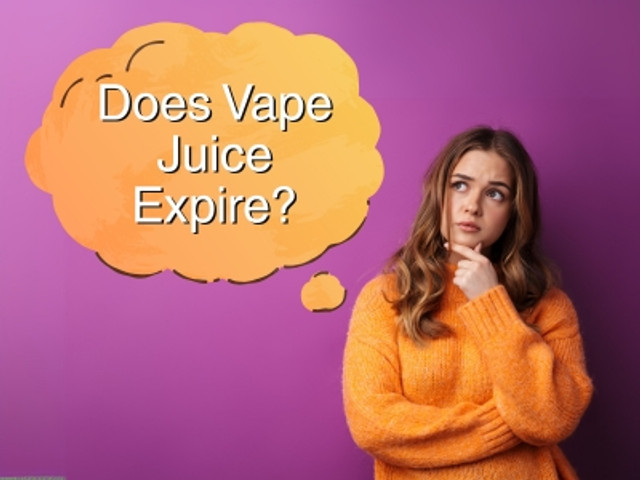
Vape juice is a key part of the vape experience, turning liquid into vapour to produce clouds and an effective nicotine replacement for cigarettes. One of the most frequently asked questions is: does vape juice expire?
Here, we explore this query to understand vape juice longevity, composition and the best way to store e-liquids to maximise its potential and reduce the chances of a nasty taste or gone-off e-liquid. By gaining insights into these aspects, vapers can ensure their products remain fresh and effective, saving money and avoiding an unpleasant hit of vapour.
Understanding Vape Juice Composition
Vape juice, or e-liquid is typically made up of four main ingredients: Propylene Glycol (PG), Vegetable Glycerine (VG), nicotine and flavourings. Each component plays a vital role in the overall vaping experience, influencing taste, cloud production and throat hit.
The balance and quality of these ingredients determine not only the immediate satisfaction from vaping but also the longevity and safety of the vape juice over time.
Explaining the Key Ingredients of E-Liquids
Propylene Glycol and Vegetable Glycerine are the primary carriers in vape juice. PG is known for its ability to carry flavour effectively and provide a stronger throat hit, while VG is thicker, offering smoother hits and larger vapour clouds. These two substances are the backbone of any e-liquid, serving as the base that delivers nicotine and flavour to the user.

Both PG and VG are stable compounds with a substantial shelf life, typically extending beyond two years when stored properly. They do not spoil but can degrade over time, affecting vape juice performance and taste.
Nicotine is another critical component whose potency can diminish over time. As nicotine degrades, it can contribute to a change in the vape juice flavour profile and effectiveness. This degradation can lead to a weaker throat hit and less nicotine satisfaction, affecting the overall vaping experience.
Additionally, flavourings used in e-liquids can lose their intensity, leading to a less satisfying experience.
Does Vape Juice Expire?
The straightforward answer is yes, vape juice can expire. The date from a respectable vape juice manufacturer should be displayed clearly on the packaging. However, this expiration is not as immediate as that of perishable goods.
There is no regulated expiration date for e-liquids, however, we would normally expect high-quality e-liquids from brands like Vsavi, Elux Legend and Vuse to stay in excellent condition for up to two years.
Once opened, they should last between six months to one year. However, if you buy a very cheap e-liquid, you will likely notice the deterioration of your liquid much sooner. The degradation process is gradual, influenced by multiple factors, including exposure to light, air, and heat.
This gradual change means that vapers may not notice the decline in quality until it becomes significant, highlighting the importance of proper storage from the outset.
There are many factors which could affect how long your e-liquid lasts including the quality of Propylene Glycol (PG), Vegetable Glycerine (VG) or nicotine it contains, the flavours and the ratios these are all mixed at.
Shelf-Life Considerations
1.Unopened vape juice: Typically, unopened vape juice can last up to two years if stored correctly, away from heat, light, and air. The sealed environment protects it from external factors that could accelerate degradation, making it crucial to keep e-liquids in their original packaging until use.
2.Opened vape juice: Once opened, exposure to air begins the degradation process. You may wonder, "how long does vape juice last once opened?" Generally, it is advisable to use it within six months for optimal flavour and performance. After opening, the e-liquid is more susceptible to changes, so consuming it within this timeframe ensures the best experience.
Key Indicators of Expired Vape Juice
Colour changes: One of the most noticeable signs of expired vape juice is a colour change. For instance, you might wonder, "is it bad if my vape juice turns brown?" While a slight darkening is common, especially in nicotine-containing liquids, significant colour changes can indicate degradation. A drastic colour shift might suggest that the e-liquid has undergone chemical changes that could affect its taste and effectiveness.
Texture and separation: Over time, the ingredients in vape juice may separate. If vigorous shaking does not restore the original consistency, it could be a sign of expiration. Consistent separation can indicate that the components are breaking down and might not provide the intended vaping experience.
Flavour and smell: A diminished or off-putting flavour and smell are clear signs that the vape juice is past its prime. For instance, citrus or menthol tones can start to taste especially harsh, ‘off’ or may turn the e-liquid cloudy. These sensory changes can significantly alter the enjoyment of vaping, making it essential to identify them early.
Nicotine potency: As nicotine degrades, the throat hit and overall satisfaction may decrease, signalling that the vape juice is no longer at its best. This reduction in potency can affect users who rely on a specific nicotine level for satisfaction. You should make sure you keep your vape juice sealed. If oxygen can get into the bottle, then there is a much higher chance of a drop in nicotine or the e-liquid going sour. Ensure that the lid is screwed on tightly when not in use and do not leave the lid off for extended periods.
Temperature change: If a vape juice becomes too warm or too cold, it can expire. Direct sunlight and extreme heat will make your vape juice go off. To keep e-liquids at their optimum, they should be stored in a dark and cool place, preferably at room temperature.

Storage Tips for Maximum Longevity
To extend the life of your vape juice, proper storage is paramount. Here are some tips to help maintain the quality and longevity of your e-liquids:
1. Store in a cool and dark place: Store vape juice in a cool, dark place, away from direct sunlight and heat sources. Do not store too underground like in a basement as this may be too dark and cold. Remember that extreme temperatures can also accelerate the degradation process. A consistent environment helps preserve the integrity of the ingredients, ensuring they remain effective for longer. Our advice is to keep in a cupboard or bedside draw.
2. Seal tightly: Ensure bottles are tightly sealed to minimise air exposure. This is particularly important for nicotine-containing e-liquids, as oxidation can occur rapidly. Keeping the bottle sealed when not in use prevents unwanted chemical reactions that could alter the vape juice properties. A top tip is to add your vape juice to glass bottles, which better resists temperature and air changes.
3. Keep at optimum temperatures: Store your e-liquids ideally between 5°C and 25°C to avoid extreme heat or damp and cold conditions.
Conclusion
In conclusion, while vape juice does expire, with proper understanding and storage, its shelf life can be maintained to get the most from your purchase.
While there is not a great deal of evidence to support the safety of vaping expired vape juice, it is recommended that you avoid vaping expired juice due to the potential side effects such as a dry throat or cough. Although e-liquid is unlikely to cause any serious harm, especially when compared to the chemicals found in traditional cigarettes if you are not sure about the look, smell or taste of your vape juice, the best solution is to throw it away.
If shaking the juice does not properly redistribute any clumps or sediment lingering in the bottle, throw out the juice, as it is likely to taste unpleasant, even if still safe.
By paying attention to storage conditions and expiration indicators, you can maximise the life and value of your vape juice to last as intended.
Vape juice is a key part of the vape experience, turning liquid into vapour to produce clouds and an effective nicotine replacement for cigarettes. One of the most frequently asked questions is: does vape juice expire?
